Roman Forum Art Story | Location | Opening Hours Tickets | Authorisations
Art Story Mythical Place | Temples Vestals
Roman Forum Temples in Rome in Italy
The Temple of Vesta at the Roman Forum
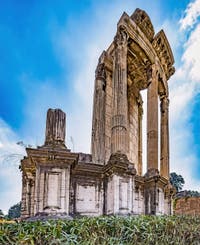
The Vesta Temple The first temple of the Vestals that was built on the Forum was just a simple round wooden hut covered with a straw roof.
In fact, as a result of numerous fires and successive reconstructions, they end up reconstructing it in stones.
The temple of the Vestals was therefore enlarged and rebuilt in marble, but keeping its original round shape.
It was Julia Domna, the wife of Emperor Septimius Severus, who built the final version of the circular temple dedicated to the worship of the goddess Vesta in the late second century AD.
The temple was surrounded by an elegant portico of fluted Corinthian columns.
There is still a good part of this temple and several of its columns, which gives us a good idea of its size, beauty and proportions.
You can still see the hearth where the famous fire was located, constantly fed by the sacred twigs.
The House of the Vestals at the Roman Forum
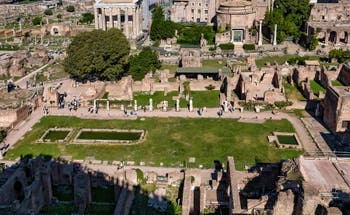
The Atrium of the Vestals House Next to the temple of Vesta is still the house or palace of the Vestals, the “Atrium Vestae” where lived the six young priestess’ virgins who were responsible for carrying out the rituals related to the worship of the goddess Vesta and to watch over the sacred fire.
We can consider this house of the Vestals as having been the ancestor of the convents: it was built around a large atrium surrounded by a double portico.
In the middle of the atrium with gardens, there were three basins of pure water fed by fountains. Around the atrium were the dwellings of the priestesses and their maids.
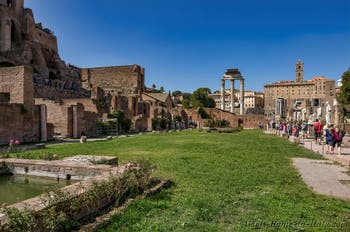
The Atrium of the Vestals House Some of these rooms containing the oven, the mill, the kitchens, but also the bathrooms of the Vestals.
A slightly larger room, the “Tablinum” served as a sacristy where three of its sides were three smaller pieces, one for each priestess.
The rooms of the Vestals were located on the second floor built on the southern flank of the Palace of the Vestals, overlooking the Via Nova, the street that passed between the Forum and the Palatine.
You can walk through this house of the Vestals and its garden, with in the centre its three ponds that were filled with pure water.
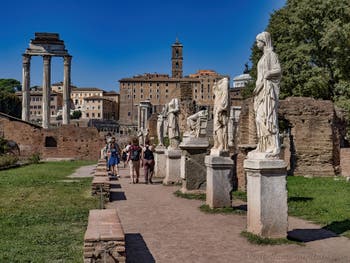
The Vestals' Statues These ponds are still surrounded by statues of the Vestals, many of which have remained in fairly good condition.
These statues are those of the Vestals having been the most deserving, those which aroused the admiration of the Romans for their virtues of chastity and morality and their perfect execution of rituals during sacred ceremonies.
Their names are engraved on the pedestal of their statues: names that you can read thinking of these women revered by the Romans.
On the other hand, one of the names was chiselled, erased from the pedestal of the statue of the Vestal which is located near the entrance. It would be the statue of the Vestal Claudia.
Indeed, the lyrical poet Aurelius Prudentius Clemens said that a Vestal named Claudia had abandoned the worship of Vesta to convert to the God of Christians, and that she was in fact removed from the order of the Vestals.
Six Vestals and Thirty Years of Priesthood
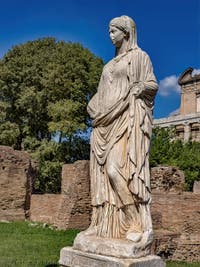
Vestal' Statue There were six Vestals; they were to commit themselves, under penalty of death, to remain virgins throughout their thirty years' priesthood.
The novices were between six and ten years old when they were admitted to the Vestals.
When they entered the order, they cut their hair and dressed them in white.
- The first ten years were intended to learn the role of the priestess,
- The next ten years serving the goddess Vesta as a priestess,
- And during their last ten years of priesthood, they taught their role as priestess to young novices.
At the end of these thirty years in the service of Vesta, they were freed from their vow of chastity, and they could marry if they so desired.
The Vestals received a significant dowry when they entered the priesthood.
A dowry they could spend as fit would seem to them.
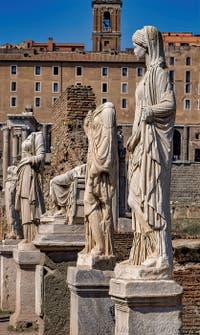
The Vestals' Statues It should be noted that the Vestals were the only women priests in Rome, which further increased the respect of the Romans for them.
They occupied an important place in Roman society because they were entitled to places of honour in all official ceremonies.
The Vestals were sitting with the emperor during the circus games at the Colosseum, close to their home.
Apart from their commitment to chastity and outside their religious service, they enjoyed some freedom.
In fact, they could travel by carriage in Rome and attend the Colosseum Games in the lodges reserved for them.
Their sacred role even gave them the power to pardon any condemned to death whom they could encounter by chance on their way.
On the other hand, their punishment was terrible if by misfortune they let the fire go out or if they lost their virginity.
In these cases, they were buried alive with bread and a little light, in a small underground room dug on Mount Quirinal, in a place with the evocative name: the “Campus Sceleratus” (villainous place).
However, there would have been no more than ten death sentences on Vestals throughout the history of Rome.
Duties and Sacrality of the Vestals
Just as in prehistoric times when the preservation of fire had become vital, the Vestals were responsible for holding the sacred flame eternally lit.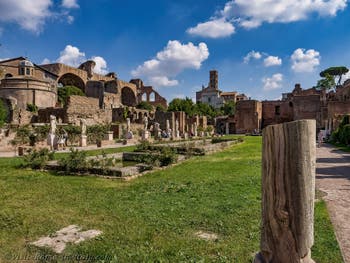
The Atrium of the Vestals House A flame that was allegedly brought to Rome from Troy by Aeneas.
It is also said that Rea Silvia, the real or mythical mother of Romulus and Remus, the founding twins of Rome, had been herself Vestal in her youth.
The sacred home maintained by the Vestals was extinguished and reignited once a year by Pontifex Maximus, the priest possessing the highest rank in the order of priests of the High Roman Empire.
He was also the only man allowed to enter the house of the Vestals.
By his function, he lived in the “Regia Pontificis”, his official residence, located right next to the house of the Vestals to which it was connected.
The public was sometimes allowed to enter the Temple of the Vestals to admire the flame that had been burning there for centuries.
The Temple of Saturn at the Roman Forum
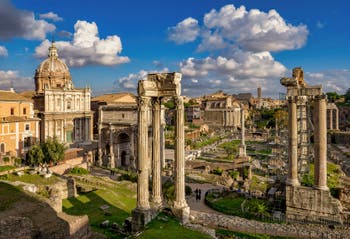
The Saturn Temple Columns Five centuries BC, the temples of Saturn and the Dioscuri were already built.
The Temple of Saturn was one of the oldest shrines in Rome.
At the foot of this temple, Emperor Augustus raised the “Miliarum Aureum”, a column around which were engraved the distances between Rome and the main cities of the Roman Empire.
The Temple of Castor and Pollux, the Dioscuri at the Roman Forum
The Temple of the Dioscuri was built following a legend.
The Temple of Castor and Pollux It was said that during a battle of the Romans against the Etruscans and the Latins, two young men of almost divine beauty had been seen riding at the head of the Roman cavalry, leading her to victory.
At the same time, two identical young men would have seen drinking their horses at the Roman Forum, giving news of the battle to those around them, telling them that the Romans had won.
Just after releasing this news, they disappeared and everyone swore that it was Castor and Pollux, the Dioscuri, Jupiter's sons.
Thus it was decided, on July 15, 499 BC, on the day of this miraculous apparition, to build in their honour on the Roman Forum, the temple of the Dioscuri.
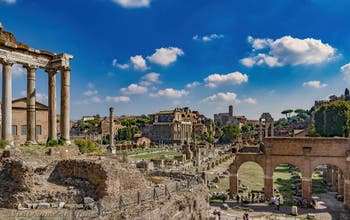
The Saturn Temple Columns This temple was several times rebuilt and embellished, its final form was given to it in the year AD 6 by Emperor Tiberius.
From the Temple of Castor and Pollux, the Dioscuri, only three imposing columns left together by an entablature.
These columns that we can admire today date from the time of Tiberius.
The Forum then began to be used to glorify not only Rome, but also celebrities.
Arches of Triumph, columns dedicated to this or that, monumental statues of “living” gods took place in the Forum.
The Roman Forum today
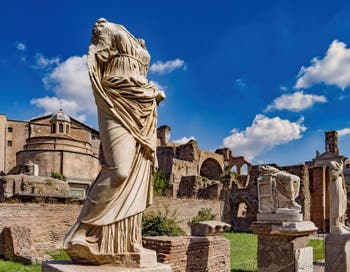
Vestal' Statue Of all these buildings, columns, statues and arches of triumph, one can still admire many remains of this greatness of the Roman Empire.
Two majestic triumphal arches still stand there, the Arch of Septimius Severus and the Arch of Titus.
Numerous columns with colossal dimensions give an idea of the imposing side of Roman temples.
The Temple of Antoninus and Faustina
The Temple of Antoninus and Faustina is one of the temples that remained in very good condition.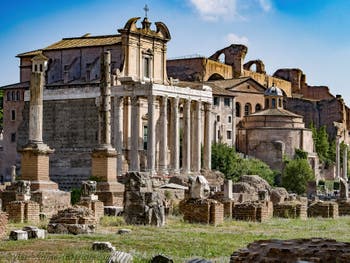
The Temple of Antoninus and Faustina It was built in AD 141 by decree of the Senate and by Emperor Antoninus the Pious in memory of his late wife, Faustina.
After his own death in 161, this temple was dedicated to Antoninus himself.
If this temple has remained in good condition, the reason is simple.
It was transformed into a church in the Middle Ages, when it became the church of San Lorenzo in Miranda and even inherited a baroque façade in 1602.
Its cipollino marble columns are 17 metres high, while their base and capitals in the Corinthian style are made of white marble.
Art Story Mythical Place | Temples Vestals
Roman Forum Art Story | Location | Opening Hours Tickets | Authorisations
Back to Top of Page

